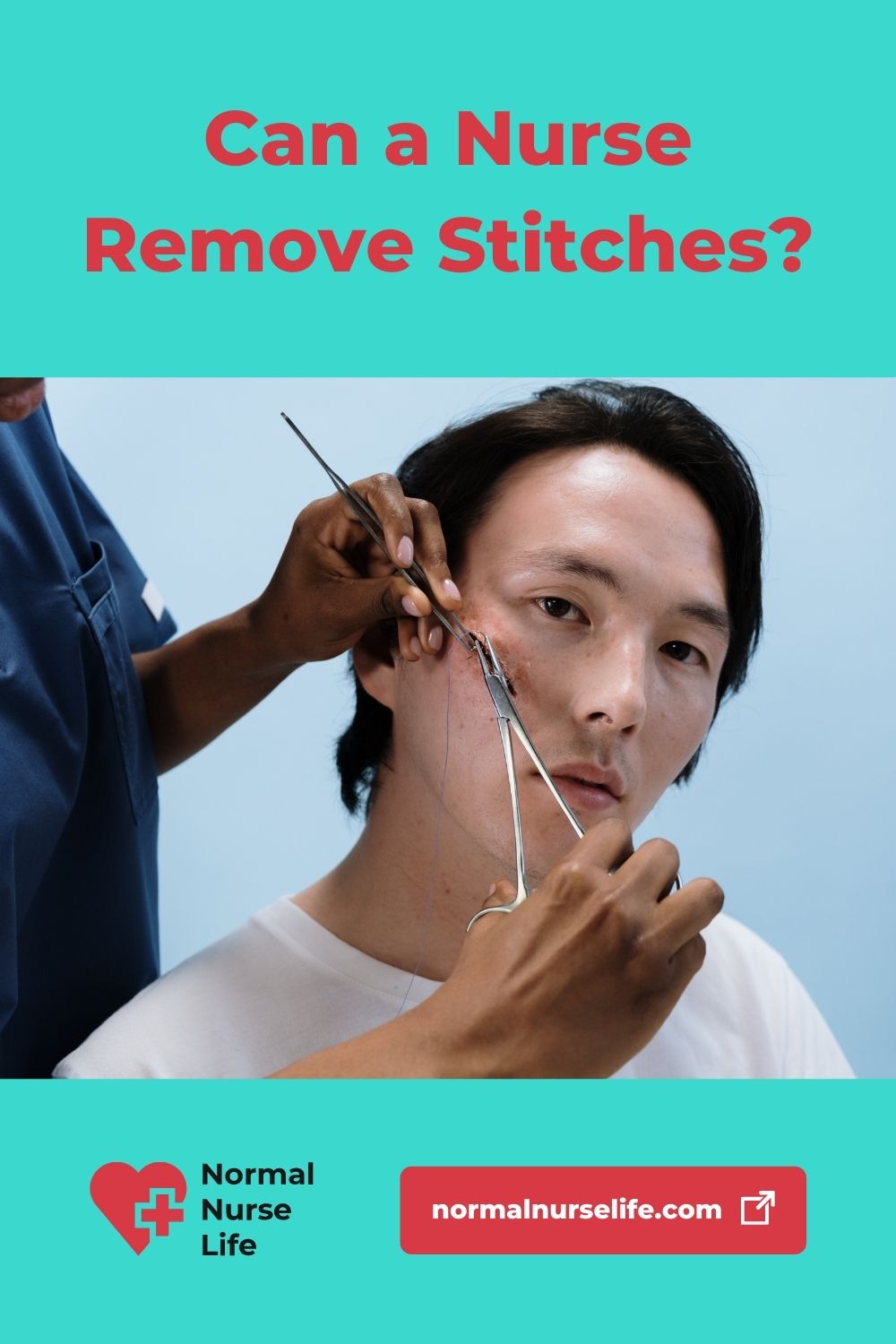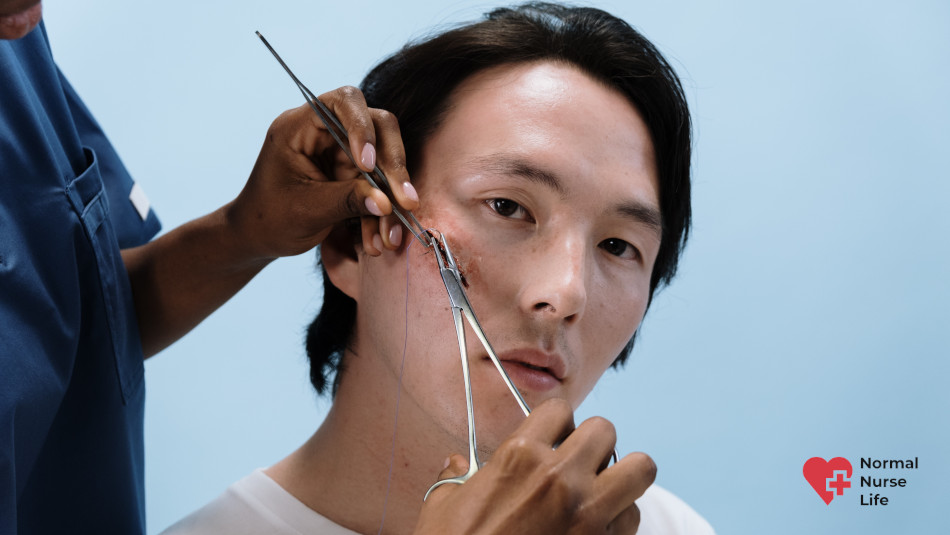Stitches are placed on the skin to attach it when a wound is too big to be closed with a bandaid. This can be used in situations where stabs or deep cuts have occurred.
We’re an affiliate
As an Amazon Associate, I earn from qualifying purchases. Thank you if you use our links, we really appreciate it! 🙂
Stitches may have a purpose for a month or so, but eventually, they need to come off.
In fact, it’s their responsibility to do so because not doing can be due to long-term consequences.
As time goes on, the skin gets weaker and the risk of the skin tearing increases every year that the stitches aren’t taken off of the skin.
Can nurses remove stitches?
There are numerous ways to take off the stitches, but it’s best to let the people who are experienced in the world of healthcare deal with it.
Generally, they are the ones who deal with this in a couple of minutes but it won’t take much effort to do so.
There are certain limitations as to how the nurse removes stitches and when they are allowed to do it.
Because they are a healthcare worker, there is a certain air of responsibility to take care of the people in their custody.
See also: Responsibility of a Nurse
When a nurse takes off those stitches, they have to do it the way the hospital has instructed them to do so.
Not doing so places a massive amount of responsibility on the hospital and that nurse could potentially lose her medical license.
Either way, getting those stitches taken off usually isn’t a painless process.
Pin me on Pinterest!

Table of Contents
Can nurses remove sutures (stitches) in California?
Despite California being the largest state in the United States by quite a large margin, the state can have some strange laws that don’t abide by what most of the country is used to.
Stitches are no exception and the state can have some strange rules as to what nurses can do with them.
To immediately answer the question, yes, nurses are allowed to remove stitches in California.
Though the circumstances are a lot less common and there are some restrictions that the nursing staff probably won’t approve of.
There’s no question as to the value that they provide to the people who come to the clinic or the hospital.
However, because of certain restrictions that the state of California has placed on the hospital, sometimes, the nurses aren’t able to do as much as they would want to do.
See also: Can Nurses Do PDO Threads?
Things could be much worse for them.
But for right now, all that really means is that the people working in the state will have to take longer to take off the stitches.
It can certainly be an inconvenience to the patients coming in for a quick take-off for the stitches on their skin.
However, they will get over it, but the hospital could suffer a bit due to this.
One pro of this law is that the staff that deals with these patients are able to be more careful so they don’t create more problems.
In general, getting these taken off in California is going to be more of a process than other states are going to do.
How do nurses remove stitches?
Stitches can be really painful to remove, but nurses usually have a very painless way to get rid of them.
Eventually, they will have to get removed because they are going to have a time when they have served their purpose and causing more harm than good.
Nurses are typically going to need a few tools to get the stitches removed.
What they will need is a pair of tweezers, a short pair of shears, and in some cases a knife or hairpin.
There are some cases where your nurse might need more but doing the actual removal only takes a few steps.
In this video, RegisteredNurseRN goes through the whole process of a nurse removing the sutures (stitches).
If it’s a more standard stitch, you need to use the tweezers to pull the string into a regular line and if the shears are near, then you cut the stitch away from the skin.
This shouldn’t be something that hurts the more it gets done, but might be painful the most couple of times.
For the benefit of the patient, this isn’t something that should be something the first couple of times.
The stitches are going to be a bit tight, but the knot part of it should be very easy to pull so that you’re able to get it out.
Once this happens the tweezers should be very easy to take the stitches out of the skin.
As long as you are patient with taking the stitches out of the skin, it shouldn’t hurt in the slightest.
You want to place the stitches on a medical cloth so you know where to dispose of them.
Conclusion: Can nurses remove stitches?
Stitches have been a revolution in the medical world for over a century.
They’ve been so useful that more people are living and those lives are lasting a much longer time than they did before.
These are good things for the communities that benefit from this kind of treatment, but what’s important is that it’s done correctly.
There are many different things that could decide whether this is going to be an easy process to get through.
Generally, getting stitches is going to be a lot more painful than getting them removed.
See also: Does Cyst Removal Hurt?
There are going to be a lot of ways to put in the stitches which means that the patient is going to make more people get it done which is a great thing.
Putting them in also could be legislated by different states.
Certain states care about the safety of their people more than others, so you could be limited based on where you live.
As long as the process is hygienic and the nurse is patient and careful in the process, everything should be fine.
Stitches were made on wounds that were too big to be patched up with a bandaid.
See also: Wound Care Nurse Interview Questions
Though these medical tools help out a lot, the body ultimately likes to heal itself, but these are just tools to make that process a bit easier.
Now you should know whether can nurses remove stitches or not and how do nurses remove sutures (stitches).
Related articles of ours:
- Can Nurses Pronounce Death?
- Can Nurses Do Ultrasounds?
- What Are Registered Nurses Not Allowed to Do?
- What Are Nurse Practitioners Not Allowed to Do?
- Can Nurses Order Lab Tests?
- Can Nurses Cut Diabetic Toenails?
I’d appreciate it if you could give this article a star rating. Thank you in advance! 🙂
